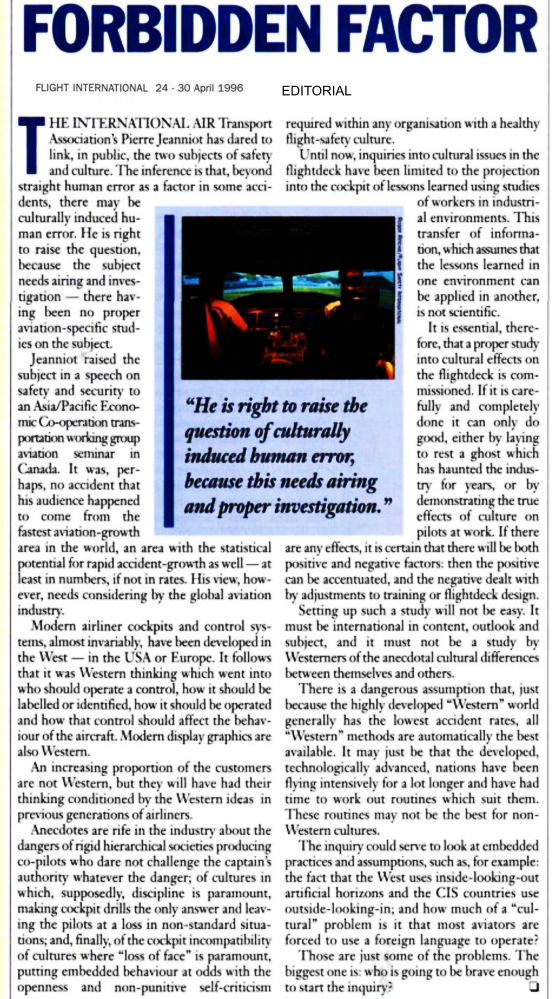Culture becomes a topic.
"Culture" is not a simple matter and manifests itself at many levels, from national to different individual fleets within an single airline.
 The need to accommodate "national" cultural differences was highlighted in a Flight International magazine editorial in 1996, following a speech by Pierre Jeanniott of IATA. It pointed out "the dangerous assumption that just because the highly developed "Western" world generally has the lowest accident rates, all "Western" methods, such as who should operate a control, etc., are automatically the best available".
The need to accommodate "national" cultural differences was highlighted in a Flight International magazine editorial in 1996, following a speech by Pierre Jeanniott of IATA. It pointed out "the dangerous assumption that just because the highly developed "Western" world generally has the lowest accident rates, all "Western" methods, such as who should operate a control, etc., are automatically the best available". In particular, the subject of monitoring effectiveness was thrown into sharp focus only 16 months later with the crash of a Korean Airlines B747 on Guam, of which more later.
Given the long-term dominance of US and European constructors in the airline industry, there is still, to paraphrase the 1996 editorial, a tendency to assume that any accepted thinking originating in the US airline industry must be appropriate everywhere. This may be generally true, but in this particular area it may well not be.
The CRM objective.
In dealing with detecting and correcting crew errors, and in particular the problem of ineffective monitoring due to excessive authority gradient, the starting point has been that a traditional "pilot" culture tended to have overly dominant Captains who need to adapt to a more consensual style.
In 1997, Bob Helmreich, perhaps the pre-eminent global expert on CRM at the time, wrote in a Scientific American article “the optimal crew would be strongly oriented towards teamwork and a consultative style of leadership in which junior officers felt encouraged to speak up to share information and advocate alternative courses of action.”
More recently, Frank J. Tullo noted in the 2010 edition of the Kanki/Helmreich/Anca standard CRM reference work that "From the beginning, the focus of CRM has been the attitude, behavior and performance of individual pilots. The objective was to eliminate the "wrong stuff" pilot. Good CRM was defined as a captain that creates an atmosphere where crewmembers feel comfortable to speak up and state opinions, ask questions and challenge if necessary".
He goes on to say "The other crewmembers are charged with speaking up regardless of the atmosphere created by the captain. This may, at times, require an aggressive posture by the crew-members, which flies in the face of the common misconception that good CRM is 'getting along in the cockpit.'" Tullo points out the current emphasis on teamwork and communication to manage threats and errors, and the need to refocus team efforts on resistance to error.
The US industry influence.
While the huge body of work involved is extremely commendable, it must be recognised that these statements reflect research predominantly carried out in the USA. This naturally carries its own cultural overtones, as well as holding by far the largest national pool of pilots to provide samples.
Consequently the core strategy of "how to improve the way pilots work together" has largely been developed from working with pilots of US origin. That means we are already starting from a position involving two overlapping cultural mindsets - that of "pilots" and that of "Americans".
The single-pilot design of most non-transport aircraft, including those used for all initial training, means the professional culture of all pilots already tends heavily toward an individualistic attitude, which CRM training generally attempts to minimise. Tullo notes that "this individualistic orientation is constantly reinforced in proficiency checks and even during advancements to new positions in the currently flown aircraft or moving into new aircraft. A pilot would much prefer to be known as a 'good stick' rather than a good team member." However, as well a "pilot" culture, there is a powerful "American" cultural influence that needs to be acknowledged here among both researchers and their subjects.
Hofstede's "Power-Distance Index"
The Dutch social psychologist Geert Hoftstede is well known for his research into how people interact in different cultures. His work was originally based on studying employees of a big multinational company in the 1980s, and some aspects of that may now be open to question as economic and social changes have been dramatic in many countries.
However, Ashleigh Merritt, who worked extensively with Bob Helmreich, later validated Hofstede's work as having some general applicability to the pilot community, although her data sample was relatively small for some countries. This work provides some very valuable perspectives on crew interaction. At its simplest, it shows that the Cross-Cockpit Authority Gradient (CCAG) will be naturally steeper on flight decks with pilots of some backgrounds than in others.
Combined with the effect of "mitigation" (adaptation of the forcefulness with which pilots of different status actually intervene), national cultural factors can greatly influence the effectiveness of cross-cockpit monitoring. Almost always they will act in the direction of reducing it below the level which CRM training aims to achieve.